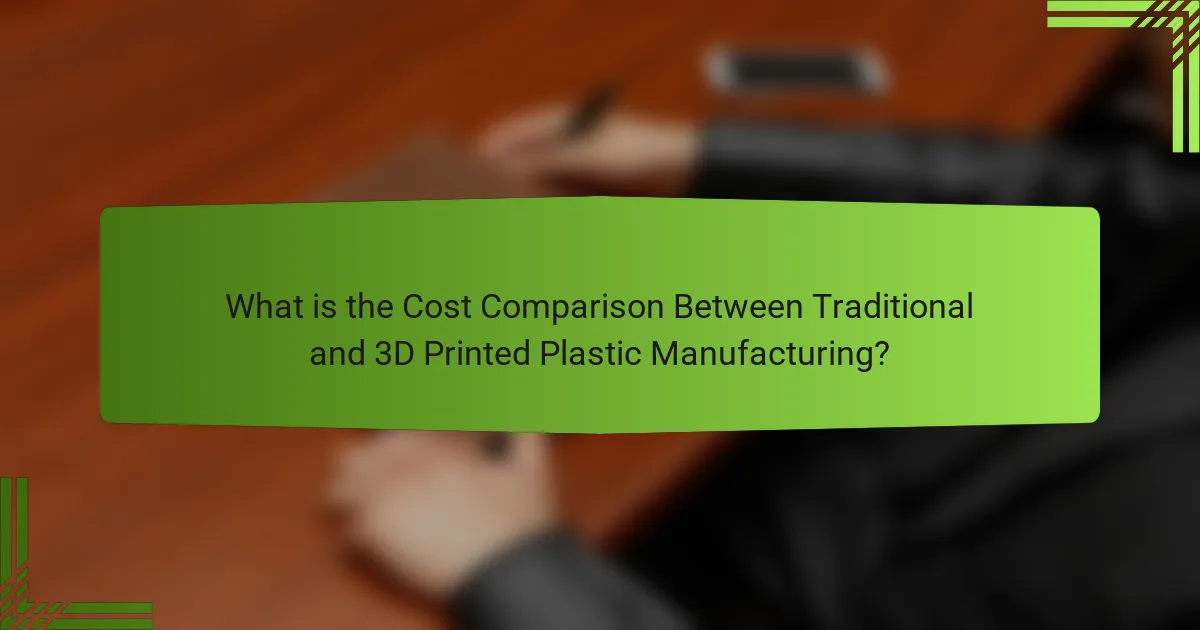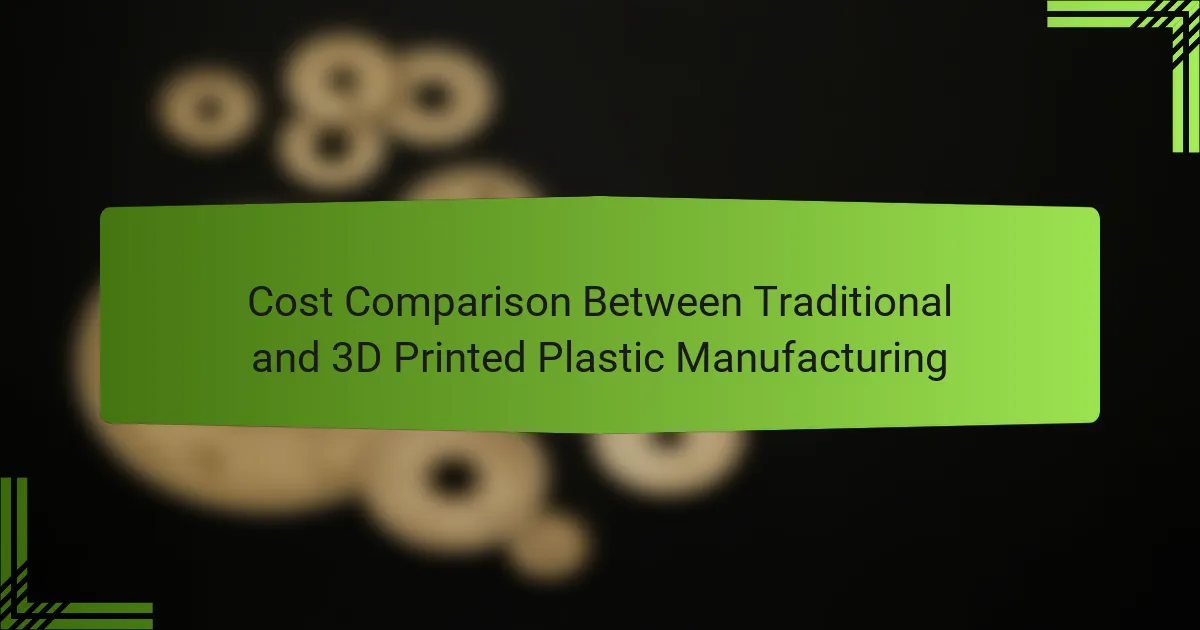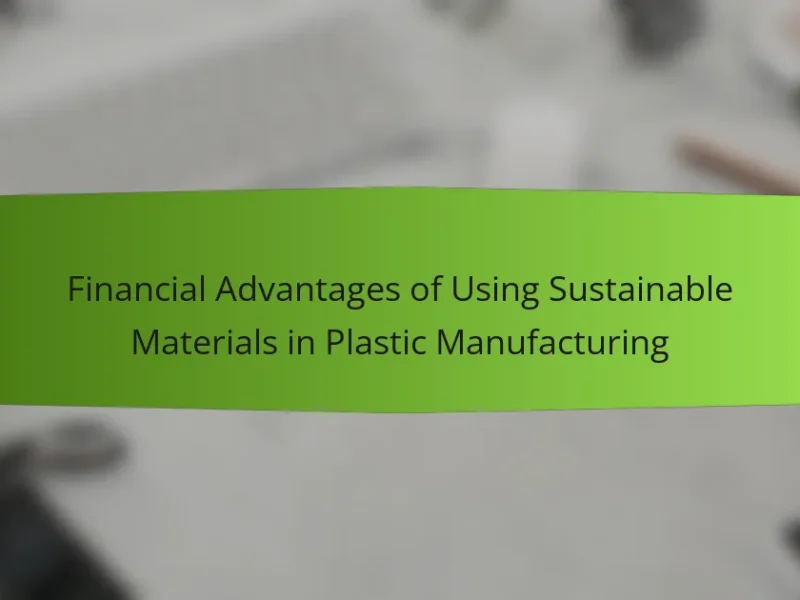The article examines the cost comparison between traditional and 3D printed plastic manufacturing. It highlights that 3D printing is often more cost-effective for low-volume production due to the elimination of high upfront costs associated with tooling and molds. Traditional manufacturing excels in high-volume production but incurs significant initial investments and longer lead times. Key factors discussed include material costs, labor expenses, production time, and design flexibility, with an emphasis on how businesses can conduct a thorough cost-benefit analysis to determine the most efficient manufacturing method for their specific needs. The article also addresses the challenges and advantages of each production method, providing a comprehensive overview for decision-makers.

What is the Cost Comparison Between Traditional and 3D Printed Plastic Manufacturing?
The cost comparison between traditional and 3D printed plastic manufacturing shows that 3D printing can be more cost-effective for low-volume production. Traditional manufacturing often requires high upfront costs for tooling and molds. In contrast, 3D printing eliminates these costs, allowing for on-demand production. According to a study by Wohlers Associates, 3D printing can reduce material waste by up to 90% compared to traditional methods. This waste reduction translates to lower material costs. Additionally, 3D printing can significantly shorten lead times, which can further reduce overall costs. For high-volume production, traditional methods may still be cheaper due to economies of scale. However, for prototyping and small batches, 3D printing is typically more economical.
How do traditional plastic manufacturing methods differ from 3D printing?
Traditional plastic manufacturing methods involve processes like injection molding and extrusion. These methods create parts by shaping molten plastic in molds. They require high initial setup costs for molds and machinery. Production runs are often large to justify these costs, making them less flexible for small batches.
In contrast, 3D printing builds objects layer by layer from digital models. It allows for rapid prototyping and customization with minimal setup costs. 3D printing is more suitable for small production runs. This flexibility reduces waste and can lower costs for unique designs.
Overall, traditional methods focus on mass production efficiency, while 3D printing emphasizes customization and adaptability.
What are the key processes involved in traditional plastic manufacturing?
The key processes involved in traditional plastic manufacturing include polymerization, molding, extrusion, and fabrication. Polymerization is the chemical process that converts monomers into polymers. This process can occur through various methods such as addition or condensation polymerization. Molding involves shaping the plastic into specific forms using techniques like injection molding or blow molding. Extrusion is the process of forcing melted plastic through a die to create continuous shapes like sheets or films. Fabrication refers to the assembly and finishing of plastic products, which may include cutting, welding, or surface treatment. These processes are essential for producing a wide range of plastic products efficiently and at scale.
How does the 3D printing process work in plastic manufacturing?
The 3D printing process in plastic manufacturing involves creating objects layer by layer from a digital model. Initially, a 3D model is designed using computer-aided design (CAD) software. This model is then sliced into thin horizontal layers by slicing software. The 3D printer reads this sliced model and deposits plastic material, typically in filament form, layer by layer.
Common printing technologies include Fused Deposition Modeling (FDM) and Stereolithography (SLA). FDM works by melting plastic filament and extruding it through a nozzle. SLA uses a laser to cure liquid resin into solid layers.
Each layer is fused to the previous one, building the object from the bottom up. This additive manufacturing process allows for complex geometries and reduced material waste. In 2021, the global 3D printing market was valued at approximately $13.7 billion, indicating its growing significance.
What factors influence the cost in both manufacturing methods?
Factors influencing the cost in both traditional and 3D printed plastic manufacturing include material costs, labor expenses, production speed, and equipment investment. In traditional manufacturing, bulk material purchasing can reduce costs but requires significant initial investment in machinery. Labor costs are typically higher due to the need for skilled workers and longer production times.
In contrast, 3D printing often involves higher material costs per unit but allows for on-demand production, reducing waste. Labor expenses in 3D printing can be lower since fewer workers are needed for operation. Production speed in 3D printing can vary based on the complexity of the design, while traditional methods generally produce items faster for high-volume runs.
Equipment investment also differs; traditional manufacturing requires costly molds and tooling, while 3D printing machines can be expensive but eliminate the need for molds. These factors collectively determine the overall cost structure for each manufacturing method.
How do material costs compare between traditional and 3D printing?
Material costs for traditional manufacturing are generally higher than for 3D printing. Traditional methods require substantial upfront investment in molds and tooling. This can lead to higher costs for small production runs. In contrast, 3D printing eliminates the need for these molds. Material costs for 3D printing can also be lower due to reduced waste. Traditional methods often produce excess materials that are discarded. According to a study by Wohlers Associates, 3D printing can reduce material costs by up to 90% in some cases. This makes 3D printing a more cost-effective option for certain applications.
What role does labor play in the cost of each manufacturing method?
Labor significantly impacts the cost of each manufacturing method. In traditional manufacturing, labor costs are typically higher due to the need for skilled workers, manual assembly, and longer production times. For example, processes like injection molding require operators to manage machinery and oversee production, which adds to labor expenses.
Conversely, 3D printing often reduces labor costs. It requires less manual intervention and can automate processes, leading to lower workforce needs. A study by Wohlers Associates indicates that 3D printing can cut labor costs by up to 50% compared to traditional methods.
Overall, labor costs vary significantly between these methods, influencing the total manufacturing cost.
How do production scale and volume impact overall costs?
Production scale and volume significantly impact overall costs in manufacturing. Higher production volumes typically lead to lower per-unit costs due to economies of scale. As production increases, fixed costs are spread over more units, reducing the average cost per item. For instance, in traditional manufacturing, larger batch sizes can decrease setup and labor costs per unit. In 3D printing, while initial setup costs can be high, producing larger volumes can optimize material usage and reduce waste. A study by the National Institute of Standards and Technology found that scaling up production can lead to cost reductions of up to 30% in certain manufacturing processes. Thus, both production scale and volume are critical in determining overall manufacturing costs.

What are the advantages and disadvantages of each manufacturing method?
Traditional manufacturing methods offer high production rates and established quality control processes. They are often more cost-effective for large-scale production. However, they require significant upfront investment and longer lead times. Traditional methods also have limitations in design flexibility and can lead to material waste.
3D printing, on the other hand, allows for rapid prototyping and customization. It reduces material waste and can produce complex geometries that traditional methods cannot. However, 3D printing typically has slower production speeds and higher costs per unit for large quantities. The technology may also face challenges in scaling for mass production.
In summary, traditional manufacturing excels in speed and cost for large volumes, while 3D printing offers flexibility and reduced waste but struggles with speed and cost for mass production.
Why might businesses choose traditional plastic manufacturing over 3D printing?
Businesses might choose traditional plastic manufacturing over 3D printing due to cost-effectiveness and scalability. Traditional methods, such as injection molding, often have lower per-unit costs when producing large quantities. The initial setup costs can be high, but the economies of scale reduce costs significantly with mass production. In contrast, 3D printing tends to be more expensive for large runs because each item is built individually. Additionally, traditional manufacturing provides faster production speeds for bulk items, which is crucial for meeting high demand. According to a study by Wohlers Associates, traditional methods can produce thousands of parts in the same time it takes 3D printing to create a few. Thus, businesses prioritize traditional manufacturing for its cost efficiency and speed when producing large volumes.
What are the benefits of using traditional methods in large-scale production?
Traditional methods in large-scale production offer several benefits. They typically provide lower production costs due to established processes. Traditional techniques often utilize existing machinery, which reduces investment in new equipment. Additionally, these methods can achieve higher output rates, maximizing efficiency. Consistency in product quality is another advantage, as established workflows minimize variability. Furthermore, traditional methods benefit from a skilled workforce familiar with the processes. This expertise can lead to fewer errors and faster problem resolution. Historical data shows that traditional manufacturing methods have been successfully employed for decades, proving their reliability in various industries.
What limitations do traditional methods face in terms of design flexibility?
Traditional methods face significant limitations in design flexibility. These methods often rely on fixed tooling and molds. This restricts the ability to make quick design changes. Adjusting molds can be time-consuming and costly. Traditional manufacturing also limits complex geometries. Intricate designs may be difficult or impossible to achieve. Additionally, material constraints can affect design options. Certain materials may not be suitable for specific designs. Overall, traditional methods lack the adaptability found in modern techniques like 3D printing.
What are the benefits of 3D printed plastic manufacturing?
3D printed plastic manufacturing offers several benefits. It allows for rapid prototyping, significantly reducing the time from design to production. This technology enables complex geometries that traditional methods cannot achieve. Material waste is minimized, as 3D printing uses only the necessary amount of material. It also supports customization, allowing for tailored products without additional tooling costs. Cost efficiency is enhanced, particularly for small production runs. According to a study by Wohlers Associates, 3D printing can lower production costs by up to 70% in some cases. Additionally, it fosters innovation by enabling designers to experiment with new ideas quickly. Overall, these advantages position 3D printed plastic manufacturing as a compelling alternative to traditional methods.
How does 3D printing enhance design customization and prototyping?
3D printing enhances design customization and prototyping by allowing for rapid iteration and complex geometries. This technology enables designers to create intricate shapes that are often impossible with traditional manufacturing methods. It supports personalized designs tailored to specific user needs, increasing product relevance. Prototyping becomes faster, reducing the time from concept to physical model. According to a study by Wohlers Associates, 3D printing can reduce prototyping costs by up to 90% compared to traditional methods. This capability facilitates testing and refinement, leading to improved final products. Overall, 3D printing transforms the design process, making it more flexible and efficient.
What environmental benefits are associated with 3D printing?
3D printing offers significant environmental benefits. It reduces material waste by using only the necessary amount of raw material. Traditional manufacturing often results in excess waste during the production process. 3D printing can utilize recycled materials, further decreasing the demand for new resources. This process also lowers energy consumption compared to conventional methods. For instance, studies show that 3D printing can reduce energy use by up to 90% in some applications. Additionally, 3D printing enables localized production, minimizing transportation emissions. By producing items closer to their end-use locations, the carbon footprint associated with shipping is significantly reduced.

How can businesses effectively analyze their manufacturing options?
Businesses can effectively analyze their manufacturing options by conducting a thorough cost-benefit analysis. This involves comparing the costs associated with traditional manufacturing methods and 3D printing. Key factors to consider include material costs, labor expenses, and production time. Businesses should also evaluate the scalability of each option. For instance, traditional methods may have higher upfront costs but lower per-unit costs at scale. In contrast, 3D printing can offer flexibility and customization at a potentially higher unit cost. Additionally, businesses should assess the quality and durability of the products produced by each method. Finally, obtaining quotes from suppliers and manufacturers can provide concrete financial data to inform decision-making. This systematic approach ensures that businesses choose the most cost-effective and efficient manufacturing method for their needs.
What tools or methods can be used for cost analysis in manufacturing?
Cost analysis in manufacturing can be conducted using various tools and methods. Commonly used tools include cost accounting software, which helps track expenses and revenues. Activity-based costing (ABC) is another method that allocates costs based on actual activities. Cost-volume-profit (CVP) analysis evaluates how changes in costs and volume affect profits.
Lean manufacturing techniques focus on minimizing waste and reducing costs. Additionally, financial modeling tools assist in forecasting and budgeting. Benchmarking against industry standards provides insights into cost efficiency. Simulation software can model different manufacturing scenarios to analyze cost implications.
These methods and tools are widely recognized in the industry for their effectiveness in providing accurate cost analysis.
How can businesses assess their specific needs to choose the right method?
Businesses can assess their specific needs by analyzing production requirements and cost constraints. They should evaluate the volume of production needed. High-volume production often favors traditional methods. Low-volume or customized production may benefit from 3D printing.
Next, businesses should consider material specifications. Different methods offer varying material options. Understanding the desired properties of the final product is crucial.
Additionally, businesses must assess lead times and flexibility. Traditional manufacturing often has longer lead times. In contrast, 3D printing allows for rapid prototyping and adjustments.
Finally, businesses should analyze their budget for initial investment and ongoing costs. Traditional methods may have higher upfront costs. 3D printing may save costs in the long run for specific applications.
By systematically evaluating these factors, businesses can make informed decisions on the most suitable manufacturing method.
What common pitfalls should companies avoid when comparing costs?
Companies should avoid overlooking hidden costs when comparing manufacturing methods. Hidden costs can include maintenance, labor, and material waste. Failing to account for these can lead to inaccurate cost assessments. Additionally, companies should not ignore the long-term implications of initial savings. Short-term cost reductions may result in higher expenses over time. Companies must also avoid comparing only direct costs without considering overall efficiency. Efficiency impacts production speed and resource utilization. Lastly, using outdated or irrelevant data can mislead cost comparisons. Accurate, current data ensures valid evaluations.
What best practices should companies follow when deciding between manufacturing methods?
Companies should conduct a thorough cost analysis when deciding between manufacturing methods. This includes evaluating material costs, labor expenses, and overhead. Companies should also assess production volume requirements. Higher volumes may favor traditional methods, while lower volumes can benefit from 3D printing.
Additionally, companies should consider lead times for each method. Traditional manufacturing often requires longer setup times compared to 3D printing. Quality control measures must also be evaluated. Each method has different tolerances and quality assurance processes.
Companies should analyze flexibility and scalability of each method. 3D printing offers more design flexibility, while traditional methods may limit options. Lastly, companies should review technological advancements. Innovations in 3D printing can reduce costs and improve efficiency.
The main entity of this article is the cost comparison between traditional and 3D printed plastic manufacturing. The article outlines the financial implications of both methods, highlighting that 3D printing is often more cost-effective for low-volume production due to the elimination of tooling costs and significant waste reduction. It discusses key processes involved in each manufacturing method, factors influencing costs, and the advantages and disadvantages of traditional versus 3D printing. Additionally, the article emphasizes the importance of analyzing production needs and costs to determine the most suitable manufacturing method for businesses.


